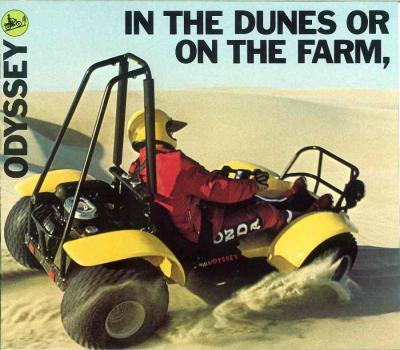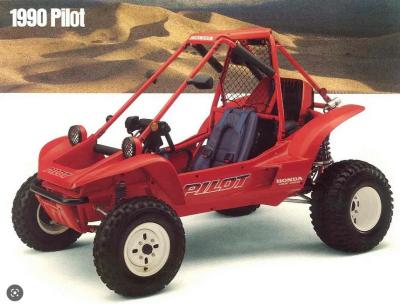In the late 1970s and 1980s, Honda revolutionized the all-terrain vehicle (ATV) market with the introduction of the Honda Odyssey FL250, FL350R, and later, the Pilot FL400R. These innovative machines combined the thrill of off-road driving with enhanced safety features, capturing the imagination of outdoor enthusiasts worldwide.
The Birth of a Safer Alternative: From Three-Wheelers to Four-Wheelers
During the early 1970s and 1980s, three-wheeled ATVs were immensely popular but posed significant safety risks due to their instability. The U.S. Consumer Product Safety Commission (CPSC) reported thousands of injuries and numerous fatalities associated with these vehicles. Public outcry and legal pressures mounted, urging manufacturers to address the escalating safety concerns.
The Safety Crisis of Three-Wheeled ATVs
Three-wheelers were prone to tipping and rolling over, especially when maneuvered by inexperienced riders. The lack of stability led to severe accidents, prompting lawsuits and negative publicity that threatened the ATV industry's future.
Honda's Innovative Response
In response to the crisis, Honda introduced the Odyssey series, pioneering a shift from three-wheelers to four-wheeled ATVs. The Honda Odyssey FL250, launched in 1977, featured a low center of gravity, four-wheel stability, and crucial safety enhancements like a roll cage and seat belts. These features were revolutionary at the time, emphasizing rider protection without compromising the off-road experience.
The subsequent models, FL350R and Pilot FL400R, continued to improve on safety and performance. They incorporated advanced suspension systems, more powerful engines, and refined ergonomics, appealing to both casual riders and enthusiasts seeking adrenaline-pumping adventures.
The Cultural Impact of the Honda Odyssey and Pilot
The Honda Odyssey and Pilot series quickly became cultural icons among off-road enthusiasts. They offered an accessible entry point into the world of off-roading for individuals uncomfortable with traditional ATVs or dirt bikes. Families embraced these vehicles for recreational activities, and they became a staple at outdoor events and off-road parks.
Community and Recreational Use
The community that formed around the Odyssey and Pilot series was passionate and tight-knit. Owners organized group rides, races, and events, fostering a culture of camaraderie and shared adventure. The vehicles' unique design and performance capabilities also attracted attention in competitive racing circuits, further cementing their legacy in ATV culture.
Pricing Over the Years: A Look Back
Understanding the original pricing of these machines provides insight into their market positioning and accessibility.
- Honda Odyssey FL250: First sold in 1977 with an MSRP of $1,195 USD. Adjusting for inflation, this is equivalent to approximately $5,315.38 USD in 2023.
- Honda Odyssey FL350R: Debuted in 1985 with an MSRP of $3,298 USD. Adjusted for inflation, this equates to about $7,865.16 USD in 2023.
- Honda Pilot FL400R: Released in 1989 with an MSRP of $6,498 USD. Adjusting for inflation, this is roughly $14,196.29 USD in 2023.
It's important to note that actual sale prices varied based on location, dealer markups, and additional taxes or fees. These figures reflect the manufacturer's suggested retail price and provide a historical context for their value.
Factors Leading to the Decline of the Honda Odyssey and Pilot ATVs
Despite their innovative design and cultural impact, several factors contributed to the decline of the Honda Odyssey and Pilot series.
High Production Costs
The advanced safety features and unique engineering of these vehicles resulted in higher production costs. Consequently, the retail prices were steep compared to other ATVs on the market, limiting their accessibility to a broader audience.
Market Competition and Shifting Preferences
The late 1980s and early 1990s saw a surge in the popularity of four-wheel ATVs (quads) and side-by-side vehicles. These alternatives offered more versatility, power, and customization options at competitive prices. Consumer preferences shifted towards these models, which were better suited for a variety of terrains and uses.
Regulatory and Legal Challenges
Increased government regulations and ongoing legal scrutiny over ATV safety led manufacturers to adopt more standardized designs. Honda, facing these challenges, decided to discontinue the Odyssey and Pilot series to focus on other product lines that met the evolving regulatory standards and market demands.
The Legacy of the Honda Odyssey and Pilot
While production ceased, the Honda Odyssey FL250, FL350R, and Pilot FL400R left an indelible mark on the ATV industry. They are celebrated for their role in advancing ATV safety and for providing a unique riding experience that combined excitement with enhanced protection.
Collector's Items and Modern Enthusiasm
Today, these models are sought after by collectors and enthusiasts who appreciate their historical significance and unique design. Restoration projects and dedicated online communities keep the spirit of the Odyssey and Pilot alive, sharing knowledge, sourcing parts, and organizing meet-ups.
Conclusion
The Honda Odyssey and Pilot ATVs represent a pivotal chapter in off-road vehicle history. Born out of a need for safer alternatives to three-wheelers, they pushed the boundaries of innovation and influenced future ATV designs. Their rise and eventual decline reflect the dynamic nature of the industry, shaped by technological advancements, market trends, and regulatory landscapes.
As we look back, the Odyssey and Pilot series remind us of a time when manufacturers dared to innovate boldly, leaving a legacy that continues to inspire and captivate the imaginations of off-road enthusiasts around the world.














